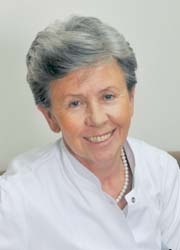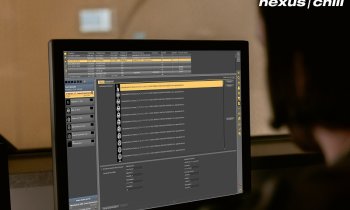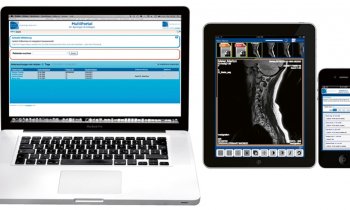Radiologists must change or lose out
The challenges definitely must be faced; we must adjust the training to the new demands'
With cardiologists and neurologists purchasing imaging equipment for use by them in their departments, clinical education has become crucial to the survival of radiologists, for whom specialist training, with a focus on particular body areas, is also imperative, says radiological interventionist Professor Malgorzata Szczerbo-Trojanowska, President of the ECR 2010.

Four years ago, during an interview with Daniela Zimmermann, interventional radiologist Professor Malgorzata Szczerbo-Trojanowska
of the Interventional Radiology Department at the Medical University of Lublin, Poland, prophesied that the most exciting thing in radiology would be developments in molecular imaging. Have her views changed? ‘It’s still molecular imaging, because radiology probably reached the edge in possibilities to show anatomical details,’ she confirmed, in our pre-ECR 2009 interview. ‘We cannot go further because we already have images that show every anatomical detail, just like an atlas of anatomy. So now radiologists’ ambitions go further. We want to see function within morphological structures, and go to the molecular composition of the cell. The main aim in radiology is to make the earliest possible diagnosis and provide clinicians with relevant data for the choice of appropriate treatment. We are reaching the point when, with molecular imaging, we can recognize pathologies going on at the level of metabolism, which are not yet visible in morphological images. With hybrid imaging we can appreciate that, although the anatomy has not changed, the metabolism is disturbed, indicating that a pathological process has already stared.’
Prof Szczerbo-Trojanowska now believes that radiology is at a very important, turning point of development and it needs critical appraisal of the position in clinical medicine. ‘Today’s images are so simple they can be interpreted by clinicians, unfortunately in many cases only at a superficial level. We are not only in competition with clinicians, but also the potential of molecular imaging is competing with nuclear medicine. If radiologists want to keep their roles as main players in the diagnostic process we must redefine it and change radiologists’ training, because we lack adequate clinical knowledge. The most important superiority we have over clinicians is our technical and basic knowledge on creation of images; we know how to develop and improve imaging modalities, whereas clinicians are obviously not so interested; they take what’s given to them. They don’t work in research to improve imaging modalities. But if, in conversations with clinicians, we don’t have enough clinical knowledge on the natural history of a disease and the available treatment options, we will definitely lose out. Therefore the big discussion now is on how to change the radiological curriculum.
‘I think we should go in two directions. First, we should include clinical training in the radiological curriculum. That’s very difficult, because every country runs it differently. Clinical training of a year or two can take place either before starting or within the radiology curriculum. Second we can no longer be only general radiologists, but must face the sub-specialization. Today, you won’t find one radiologist who could master all the huge knowledge we now have in radiology. Therefore we have to specialize in neuroradiology, musculoskeletal radiology, paediatric radiology etc. The European Society of Radiology is promoting this education system: three plus two -- three years of general radiology, then two clinically oriented years in a specialised radiological discipline. If we don’t do this, we will lose far more than we have already lost. I see that many neurologists are installing MRI equipment for their departments. Cardiologists have, for many years, been buying at least interventional radiology equipment for their departments, and claim that what they need to use it are only radiographers.
Obviously, it’s not such a catastrophic vision, but the challenges definitely must be faced. As an interventional radiologist, I believe we first must have sub-specialization, that is, one has to devote oneself to a certain radiology area. Those who are responsible for the future of radiology, worldwide, must adjust the training to the new demands.
‘I am optimistic about the launch of new types of sessions in ECR 2010. These are called multidisciplinary symposia. The focus will be on oncology. Sessions will include a surgeon, oncologist, and radiologist in discussion. The surgeon will say what he expects and what he wants to know from imaging in order to perform surgery. The oncologist will say what he wants to know from the radiologist, and the radiologists will explain what imaging can offer. The four sessions will focus on cancers of the lung, prostate, ovary and colon.
What about being invited by surgeons to their congress? ‘It would be even more important going out to clinicians. I don’t know how extensively it works in Europe, but for many years I was involved in this process in Poland. Interventional radiologists are in a way competing with vascular surgeons, neurosurgeons, gastroenterologists, urologists, but are very often invited to their meetings. For example, every year we have a meeting of three societies: vascular surgeons, angiologists, and interventional radiologists.
‘In the beginning it was diffi-
cult for interventional radiologists, because clinicians were trying to say, “Well, you aren’t clinicians” and did not show interest in cooperation. But we proved to be strong enough to keep our position. Cooperation with neurosurgeons is a good example. Neurosurgical congresses have sessions devoted to neuro-interventions, in which we always participate. On a smaller, our university scale, for a few years we’ve had combined meetings with neuroscientists. This month, we’ll have a joint meeting with neurosurgeons, where many lectures have two authors, a neurosurgeon and a radiologist. One topic, for example, is neurosurgical implants in the brain and spine; we will show how to interpret and differentiate muscle, fat or other biological material used to close the wound, how endovascular embolic materials and devices look on images. We shall share our knowledge about changes, a variety of surgical implants undergo in time and how do they influence imaging. Radiologists may lack updated knowledge about those materials. How it is put in and how much is used; whether it is in layers or solid put in one place. So, I think having those meetings together with clinicians is really very valuable.
The eastern European presence at major international events
In our previous interview, the professor had also expressed concern over the lack of adequate representation from eastern European countries in the faculty of the leading medical events. For example, she pointed out, that since 1991 about 200 Polish radiologists attended each ECR and presented scientific papers, but they were hardly seen among faculty.
‘I’m very happy that things have really changed,’ she said, during our very recent interview. ‘The percentage of speakers, session leaders and moderators from Eastern Europe is rising. In 2004, when I entered the election to become a member of the ECR’s Executive Board, one of my intentions was to bring closer radiology in Eastern Europe to ECR. I am pleased that this idea has been well taken by the board and now, more east European radiologists are involved as moderators, invited speakers and lecturers at the congress, The balance between the number of active and inactive participants is more like that of other countries.’ In the preparations for ECR 2010, she noted, many committees propose a bigger number of contributors from eastern countries.
As a result of this development scientific and educational ideas of ECR spread more extensively to the countries of Eastern Europe. European radiology is moving in a very good direction.’
06.03.2009










